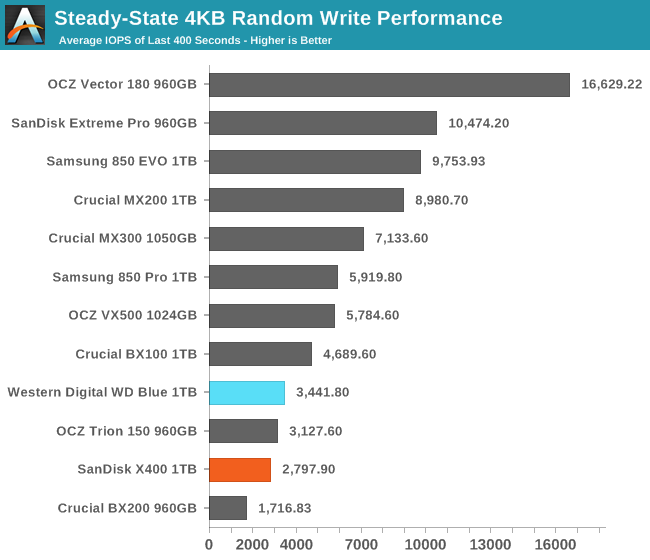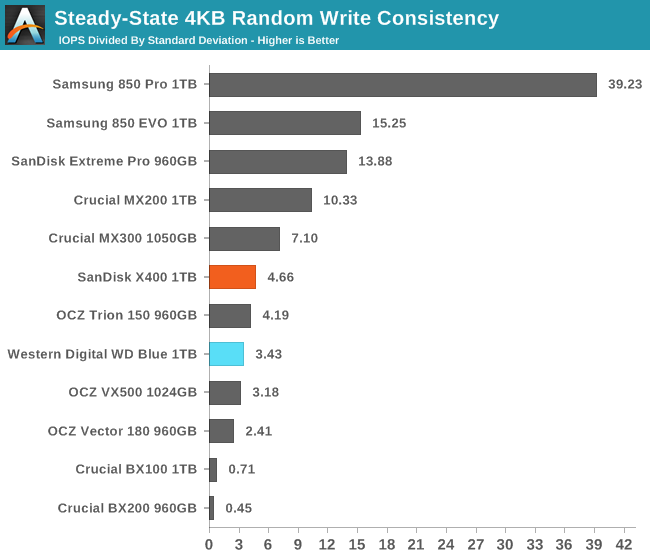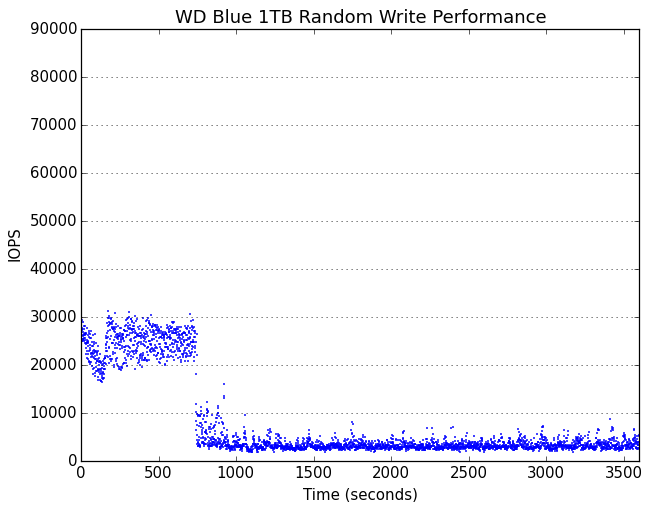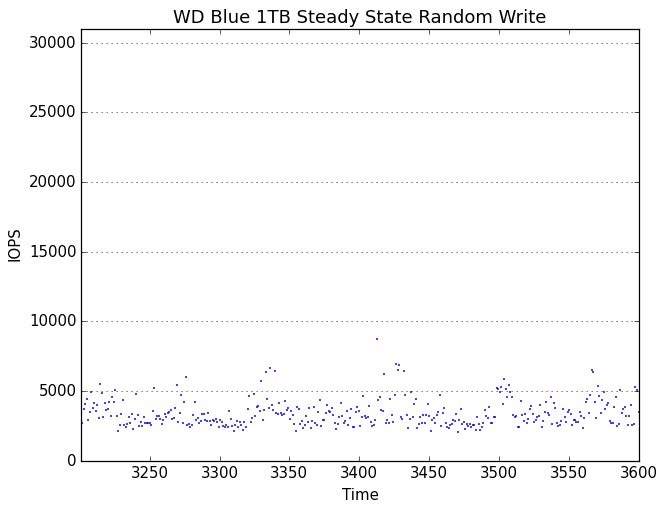The Western Digital Blue (1TB) SSD Review: WD Returns to SSDs
by Billy Tallis on October 11, 2016 8:00 AM EST- Posted in
- SSDs
- Storage
- Western Digital
- SanDisk
Performance Consistency
Our performance consistency test explores the extent to which a drive can reliably sustain performance during a long-duration random write test. Specifications for consumer drives typically list peak performance numbers only attainable in ideal conditions. The performance in a worst-case scenario can be drastically different as over the course of a long test drives can run out of spare area, have to start performing garbage collection, and sometimes even reach power or thermal limits.
In addition to an overall decline in performance, a long test can show patterns in how performance varies on shorter timescales. Some drives will exhibit very little variance in performance from second to second, while others will show massive drops in performance during each garbage collection cycle but otherwise maintain good performance, and others show constantly wide variance. If a drive periodically slows to hard drive levels of performance, it may feel slow to use even if its overall average performance is very high.
To maximally stress the drive's controller and force it to perform garbage collection and wear leveling, this test conducts 4kB random writes with a queue depth of 32. The drive is filled before the start of the test, and the test duration is one hour. Any spare area will be exhausted early in the test and by the end of the hour even the largest drives with the most overprovisioning will have reached a steady state. We use the last 400 seconds of the test to score the drive both on steady-state average writes per second and on its performance divided by the standard deviation.

With a slight increase in out of the box overprovisioning, it is unsurprising to see the WD Blue improve on the SanDisk X400's steady-state random write performance. The WD Blue overtakes the OCZ Trion 150 as the fastest planar TLC NAND SSD, but doesn't catch up to the MLC or 3D TLC drives.

The WD Blue has slightly worse performance consistency than the X400, but not low enough to be cause for concern.
 |
|||||||||
| Default | |||||||||
| 25% Over-Provisioning | |||||||||
Before reaching steady state, the WD Blue hovers between 20k and 30k IOPS, a significant improvement over the X400. Several other competitors have higher peak performance, but are either less consistent during the early phase of the test or don't last as long before dropping to steady state.
 |
|||||||||
| Default | |||||||||
| 25% Over-Provisioning | |||||||||
Upon reaching steady state, the WD Blue varies from roughly 2500 IOPS to 5000 IOPS, with short bursts of slightly higher performance. With extra overprovisioning the base performance of the WD Blue doesn't change but the upper limit of its normal band of performance increases to around 10k IOPS and the peaks reach 25k.










75 Comments
View All Comments
Lolimaster - Wednesday, October 12, 2016 - link
This article need a "The Rock" picFinally, HDD vendors make it back to consumer hearts, with an SSD.
Lolimaster - Wednesday, October 12, 2016 - link
The Mushkin Reactor is still a champ if you don't wanna go for the 850Pro.Lolimaster - Wednesday, October 12, 2016 - link
I think you only got 3-4 options for SSD's.Samsung 850Pro
Crucial MX300
Mushkin Reactor
*Add Hynix SSD's when they sell the 1TB model.
Lolimaster - Wednesday, October 12, 2016 - link
*Samsung 850Pro/EVO2016, still no edit button...
mapesdhs - Friday, October 14, 2016 - link
Sad part is we'll be saying the same thing next year.MrGulio - Wednesday, October 12, 2016 - link
Each time I see a new SSD review it reminds me more and more what a garbage fire the BX200 is.Bulat Ziganshin - Saturday, October 15, 2016 - link
here in russia samsung 750 and sandisk ultra 2 are good competition too, providing prices comparable to trion 150 devices. but on american amazon they are no better than mx300Bullwinkle J Moose - Saturday, October 15, 2016 - link
Extra large premium for the Pro???I require a minimum of 160GB for my Boot Drives in my test Rigs so I need 250 - 256GB SSD's minimum
Lets look at the Huge Premium at Newegg for the 250/256GB EVO & Pro
Oct 15 2016
850 EVO / 250GB $99.99 OUT OF STOCK
850 Pro / 256GB $123 IN STOCK
850 EVO warranty 3 years
850 Pro warranty 10 years
850 EVO TLC Nand
850 Pro MLC Nand (40nm process)
Firmware problems
850 EVO ???
850 Pro None
Would anyone here spend more than the difference in price between these 2 SSD's just for an extended warranty on an EVO?
The better buy is the Pro!
It also has much better compatability with various Operating Systems than PCIe / M.2 SSDs
I'm using mine for Windows XP / Windows 8.1 / Windows 10 and Linux Mint
Try running any OS that is not a DRM Spyware Platform on your precious M.2 drive
TheinsanegamerN - Monday, October 17, 2016 - link
linux mint/ubuntu/arch/ece love the 950 pro.SeanJ76 - Thursday, October 20, 2016 - link
Intel>all other SSD manufactuers